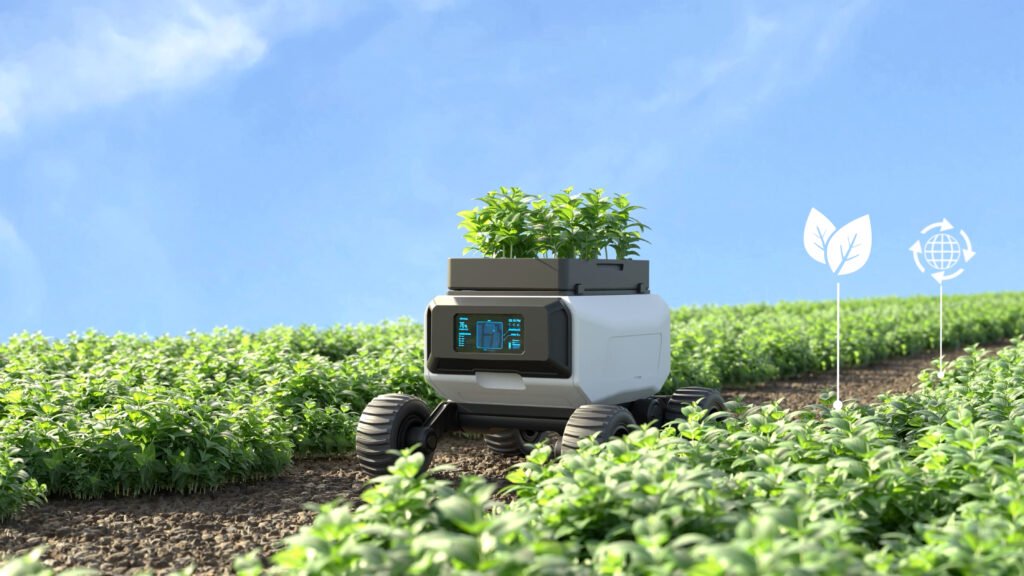I. Introduction
A. Brief Overview of the Importance of Agriculture
Agriculture stands as the backbone of human civilization, providing sustenance and raw materials for various industries. As the global population continues to burgeon, the demand for food production intensifies, necessitating innovative approaches to farming. With the advent of advanced technologies, Artificial Intelligence (AI) has emerged as a pivotal tool in transforming traditional agricultural practices.
B. Introduction to the Concept of AI in Agriculture
AI in agriculture refers to the application of technologies like machine learning, robotics, and data analytics to streamline and enhance farming processes. This integration holds the promise of significantly improving efficiency, resource management, and overall productivity.
C. Significance of Precision Farming for Sustainable Food Production
Precision farming, a subset of AI-driven agriculture, involves the use of technology to optimize various aspects of crop cultivation with a focus on accuracy and efficiency. This approach plays a crucial role in addressing challenges such as resource scarcity, climate change, and the need for sustainable farming practices.
II. The Role of AI in Agriculture
A. Overview of AI Technologies in Agriculture
1. Machine Learning and Predictive Analytics
Machine learning algorithms analyze vast datasets to identify patterns and make predictions. In agriculture, this translates to improved decision-making, as farmers can anticipate factors like crop yield, pest infestations, and optimal harvest times.
2. Robotics and Automation
Robotic systems are increasingly utilized in agriculture for tasks such as planting, weeding, and harvesting. These technologies not only reduce the labor burden on farmers but also contribute to precision and efficiency in farming operations.
3. Internet of Things (IoT) Applications
IoT devices, including sensors and monitoring systems, enable real-time data collection. This data, when analyzed, provides valuable insights into soil health, weather conditions, and crop status, facilitating informed decision-making.
B. Benefits of Incorporating AI in Farming Practices
1. Improved Efficiency and Resource Utilization
AI-driven technologies enable farmers to optimize resource usage by precisely tailoring irrigation, fertilization, and pest control efforts. This not only maximizes yield but also minimizes waste and environmental impact.
2. Enhanced Crop Monitoring and Yield Prediction
Accurate monitoring of crops, facilitated by sensors and satellite imagery, allows farmers to detect issues like disease outbreaks or nutrient deficiencies early on. Predictive analytics further aids in estimating crop yields, assisting farmers in planning and marketing.
3. Data-Driven Decision-Making for Farmers
Access to real-time and historical data empowers farmers to make informed decisions. Whether adjusting planting schedules based on weather forecasts or fine-tuning irrigation based on soil moisture levels, data-driven insights lead to more effective and sustainable farming practices.
III. Precision Farming: Key Components
A. Sensor Technologies
1. Remote Sensing and Satellite Imagery
The integration of satellite imagery and remote sensing technologies enables farmers to gain a bird’s eye view of their fields. This data helps in monitoring crop health, identifying areas of stress, and assessing the overall condition of the farmland.
2. Soil Sensors and Moisture Monitoring
Soil sensors play a pivotal role in precision farming by providing real-time information about soil composition and moisture levels. This data aids farmers in making decisions related to irrigation schedules, preventing overwatering or underhydration of crops.
3. Drones for Aerial Surveillance
Drones equipped with cameras and sensors offer a versatile solution for aerial surveillance. Farmers can use drones to monitor large areas quickly, assess crop health, and identify potential issues such as pest infestations or diseases in the early stages.
B. Data Analytics and Machine Learning Algorithms
1. Crop Health Analysis
Machine learning algorithms analyze data from various sources, including sensors and satellite imagery, to assess the health of crops. Early detection of diseases or nutrient deficiencies allows farmers to take prompt action, preventing widespread crop damage.
2. Weather Prediction and Impact Assessment
AI-driven weather prediction models provide farmers with accurate forecasts, helping them plan their activities and mitigate potential risks. Additionally, impact assessment models allow farmers to anticipate the effects of extreme weather events on their crops.
3. Yield Forecasting Models
Predicting crop yields with precision is essential for effective planning and resource allocation. AI-based yield forecasting models take into account multiple variables, including weather patterns, soil conditions, and historical data, providing farmers with insights to optimize harvest strategies.
IV. Sustainable Agriculture Practices with AI
A. Optimizing Resource Use
1. Water Management
Precision farming, enabled by AI, allows for precise control of irrigation systems. Smart irrigation technologies ensure that crops receive the right amount of water at the right time, reducing water wastage and promoting sustainable water management practices.
2. Fertilizer and Pesticide Optimization
AI algorithms analyze data on soil conditions and pest prevalence to optimize the application of fertilizers and pesticides. This not only reduces the environmental impact but also minimizes input costs for farmers.
B. Reducing Environmental Impact
1. Minimizing Chemical Usage
Precision farming aims to minimize the use of chemicals by targeting specific areas that require treatment. This not only reduces the environmental impact but also promotes healthier soil and water ecosystems.
2. Precision Irrigation to Reduce Water Wastage
Smart irrigation systems, guided by AI insights, ensure that water is applied precisely where and when it is needed. This not only conserves water but also contributes to sustainable farming practices in regions facing water scarcity.
C. Crop Diversification and Rotation Strategies
AI technologies assist farmers in analyzing data on crop performance and soil health, enabling them to make informed decisions about crop diversification and rotation. This promotes soil fertility, reduces the risk of pests and diseases, and contributes to sustainable agricultural practices.
V. Real-world Examples of AI Implementation in Agriculture
A. Case Studies Showcasing Successful Precision Farming Applications
1. Autonomous Tractors and Robotic Harvesting
Several farmers worldwide have embraced autonomous tractors equipped with AI technology for precision planting and harvesting. These machines can navigate fields with accuracy, optimizing the use of resources and reducing labor costs. Robotic harvesting, powered by computer vision and machine learning, ensures efficient and timely collection of crops, minimizing losses and maximizing yield.
2. AI-powered Crop Disease Detection
AI algorithms have been deployed to detect and diagnose crop diseases swiftly and accurately. By analyzing images of crops captured by drones or smartphones, these systems can identify early signs of diseases, allowing farmers to take immediate action to prevent the spread and minimize crop losses.
3. Smart Irrigation Systems
Smart irrigation systems, driven by AI, have been adopted in various regions to address water scarcity challenges. These systems use real-time data from sensors to determine optimal irrigation schedules, ensuring that crops receive adequate moisture while minimizing water usage. This not only conserves water but also enhances crop yield.
VI. Challenges and Future Prospects
A. Current Challenges in Implementing AI in Agriculture
1. Cost and Accessibility
While AI technologies offer numerous benefits, the initial costs of implementation can be a barrier for many farmers, particularly those in developing regions. Additionally, the accessibility of advanced technologies poses a challenge, as not all farmers have the resources or technical expertise to adopt and integrate AI solutions into their practices.
2. Data Privacy and Security Concerns
The collection and analysis of vast amounts of agricultural data raise concerns about data privacy and security. Farmers need assurance that their data is handled responsibly and securely to encourage the widespread adoption of AI technologies in agriculture.
B. Emerging Trends and Innovations
1. Integration of AI with Blockchain for Transparent Supply Chains
The integration of AI with blockchain technology holds the potential to create transparent and traceable supply chains in agriculture. This ensures the authenticity of produce, reduces fraud, and builds trust between farmers and consumers.
2. Advances in AI-driven Genetic Modification for Crop Improvement
AI is increasingly being utilized in genetic research to enhance crop characteristics such as yield, resistance to diseases, and adaptability to changing environmental conditions. This represents a promising avenue for sustainable crop improvement and addressing global food security challenges.
VII. Conclusion
A. Recap of the Benefits of AI in Precision Farming
In conclusion, the integration of AI in agriculture, particularly in precision farming, offers a multitude of benefits. From optimizing resource use to improving crop monitoring and decision-making, these technologies are transforming traditional farming practices and contributing to sustainable food production.
B. Call to Action for Increased Adoption of AI Technologies in Agriculture
As we navigate the challenges and opportunities presented by AI in agriculture, there is a growing need for collaborative efforts from governments, industry stakeholders, and research institutions to support farmers in adopting and benefiting from these technologies. Increased awareness, financial support, and education are crucial components of fostering the widespread adoption of AI in agriculture.
C. The Potential Impact on Global Food Security and Sustainability
The potential impact of AI in agriculture extends beyond individual farms; it has the power to address global challenges such as food security and sustainability. By embracing these technologies responsibly and inclusively, we can pave the way for a more resilient and sustainable future for agriculture and food production worldwide.
This comprehensive exploration of AI in agriculture and precision farming provides a glimpse into the transformative potential of these technologies. As we move forward, the collaboration between technology innovators, farmers, and policymakers will be essential in realizing the full benefits and ensuring a sustainable future for global food production.












